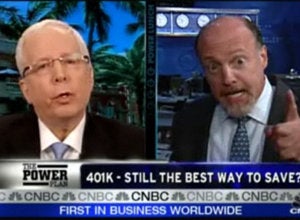
In case you missed it, Cramer and I went head-to-head during my appearance on CNBC's Power Lunch on Friday. You can see the video here.
I was asked what alternatives there were to investing in 401(k) plans. I replied that investors needed better education so they could make intelligent choices outside these plans. I then said "One of the things you could do is give us more 'In Bogle we Trust' and much less 'In Cramer we Trust'."
Cramer's unscripted, bug-eyed rant followed.
His point was that Bogle's advice has been wrong for the past decade: "In all due respect, the S&P is flat literally for ten years. That's John Bogle's world." He went on to compare "Bogle's world" to his world in which he claimed credit for advising investors when to get in and out of the markets.
The facts tell quite a different story.
As I noted after Cramer stormed off the set, either Cramer has no understanding of "Bogle's world" or he intentionally distorted Bogle's advice.
Bogle's views on investing are well documented.
He advocates determining your asset allocation and investing in a globally diversified portfolio of low cost index funds.
Cramer's assertion that Bogle suggests investors confine their investments to the S&P 500 is false. The S&P 500 does not represent an appropriate asset allocation for anyone. It is far from globally diversified. It is too risky for any individual investor. No one who knows anything about investing would suggest that investors confine their investments to an S&P 500 index fund.
Building on this distortion, Cramer asserts that the S&P 500 is "flat literally for ten years." Actually, it lost 26.5% for the ten years ending December 31, 2008.
How have followers of Bogle's actual advice fared during this period?
A moderate portfolio of 60% stocks and 40% bonds earned 36% for the ten years ending December 31, 2008.
Now that we have the results of the real "Bogle's world", let's look at Cramer's record.
Barron's conducted two studies of Cramer's stock picks.
In the first study dated August 20, 2007, Barron's concluded that "over the past two years, viewers holding Cramer's stocks would be up 12% while the Dow rose 22% and the S&P 500 16%."
Barron's revisited Cramer's stock picking skills in a second article dated February 9, 2009. Once again, Barron's concluded that Cramer's picks "underperform the markets by most measures."
Cramer also was selective about his market timing skills. As noted by Barron's, in the Spring of 2007, Cramer was the "chief cheerleader" for the bull market and "was giddily exhorting the Dow Jones Industrial average towards 15,000, with no troubles in sight." If he is going to take credit for his good calls, he should acknowledge the bad ones.
Investors have a choice. They can follow Bogle's advice and capture market returns, less low costs, with 100% certainty. Or they can be deluded into thinking that self-styled gurus like Cramer have the ability to beat the odds and pick stock winners.
The views set forth in this blog are the opinions of the author alone and may not represent the views of any firm or entity with whom he is affiliated. The data, information, and content on this blog are for information, education, and non-commercial purposes only. Returns from index funds do not represent the performance of any investment advisory firm. The information on this blog does not involve the rendering of personalized investment advice and is limited to the dissemination of opinions on investing. No reader should construe these opinions as an offer of advisory services. Readers who require investment advice should retain the services of a competent investment professional. The information on this blog is not an offer to buy or sell, or a solicitation of any offer to buy or sell any securities or class of securities mentioned herein.
